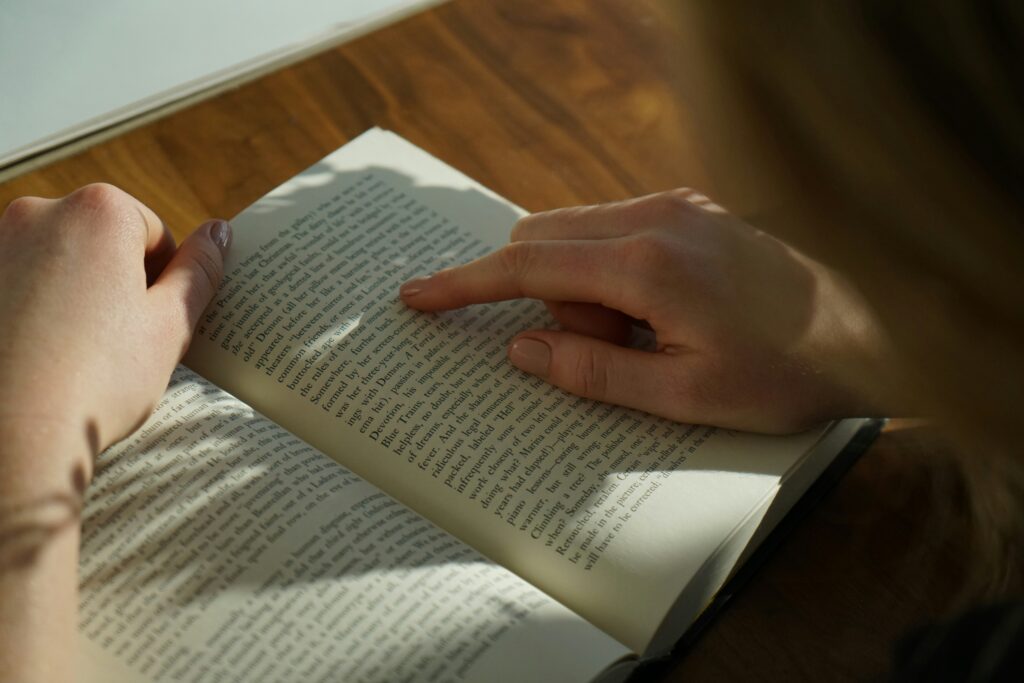It was the fall of my freshman year. I knew I wanted to major in English, but— apart from a few high school classes, a long list of favorite books, and an even longer list of books to be read—I had no experience with the discipline. And now, in my first ever college English class, I was required to “close read” a passage and then respond with an essay. I had no idea where to begin. Quite frankly, I panicked.
Maybe you find yourself in a similar situation. So, let us remove some of the terror from the name of “close reading” by examining what it means to close read, what my process is, and, most importantly, the truth that if I can close read, you can too.
Although the definition of and requirements for close reading vary from class to class, the most helpful explanation of close reading I have received came in the form of a handout from Dr. Alison Gibson in her Comedy and Tragedy class. In the document, she included a definition of the practice coined by David Mikics in his A New Handbook of Literary Terms. To paraphrase his quotation, the close reading process involves combing through a passage of text with the intent of finding each detail that the author has placed there. Then, you take what you have discovered and ponder in what ways those small details enhance your understanding of the specific passage and even the text as a whole. When we close read, we work as detectives, wading through the minutest clues left by the author (whom we trust knew what he or she was doing) and hoping they will reveal to us the beauty and significance of the entire work.

My close reading process involved three steps.
1. Type out your entire passage
Never try to close read on your computer. The secret to close reading success is manually marking every detail you see. Even if you are close reading from a book, I recommend typing out and printing your passage. Then, you have a whole sheet of paper in front of you to demolish with markings instead of demolishing your book. Our goal is to become intimately acquainted with the words and even punctuation on the page. Typing each word out for yourself helps with that goal. Also, don’t forget to double space! You’ll need lots of room for annotations.
2. Grab some pens (ideally colorful ones), and go for it!
There are three concepts that can be helpful to examine in all close reading endeavors: the author’s choices in syntax, diction, and imagery.
“Syntax” refers to sentence structure. Is the sentence simple or compound? Is it in active or passive voice? Does this passage include mostly narrative, or is dialogue involved? If you are close reading a poem, what is the rhyming scheme? Write down whatever you see on your paper.
“Diction” is word choice. As you know, English words can have different meanings in different contexts. “Denotation” refers to a word’s dictionary definition. For example, the Oxford English Dictionary defines “love” as “A feeling or disposition of deep affection or fondness for someone.” (Word to the wise: keep a dictionary nearby when you close read!) On the other hand, “connotation” refers to what a word means in a specific context. “I love you” means something very different when your mom says it and when your crush says it. When you close read, you need to figure out the word’s denotation and connotation, and then analyze why you think the author chose that word here.
“Imagery” is the fun part. Imagery will often take the form of literary devices. Even if you don’t know the word “anaphora,” you’ve experienced the pleasure of reading three or four sentences in a row that all start with the same word. Even if you don’t know the name for the images the author is conveying, you can still observe and mark the places where you see the author making rhetorical choices that creatively convey information or invoke emotion.
Now that you know what to look for, find a system of indicating each element you discover in the passage (I am a firm proponent of color-coded highlighting). I mark every place I see that element—diction, syntax, or imagery—occur. Then, in the margin or between the lines of text, I scribble down what the words mean and what they could mean, my observations about punctuation and sentence structure, and the names of literary devices if I know them. Make it messy! Later, when you write your essay, you can clean everything up and figure out why it all matters. Now we’ve reached the final step…

3. Figure out how it all fits together.
I like to ask myself one important question after I’ve close read a passage: what would happen to this piece if things were different? For instance, what would it look like if this were narration instead of dialogue? What would happen if the author replaced the word “beautiful” with “pretty”? Why does he or she use a nature metaphor here when a technology metaphor could have worked just as well?
You might not know the answers to these questions (you’re not the author!), but this practice should help you to start seeing how each piece of the passage was carefully crafted and how anything different could change the overall meaning of the whole passage. And now, with that in mind, you can write an essay exploring what the author has done and how it affects the way you read the text.
In conclusion…
Close reading is not scary. If you can read, and if you can notice things about what you’re reading, then you can close read. Although close reading represents only one means of literary interpretation, I think it might be my favorite. Because (especially if you take my advice and color-code), it is often just plain fun.